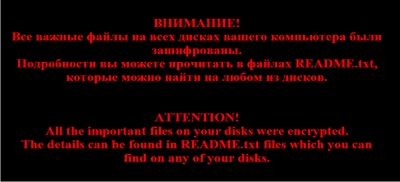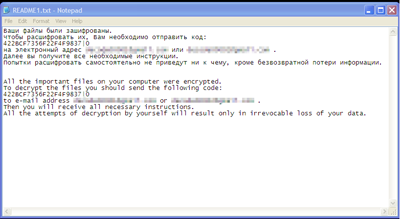TROJ_CRYPSHED.B
Ransom:Win32/Troldesh.A(Microsoft); Backdoor.Win32.Androm.gmkx(Kaspersky); Win32/Filecoder.ED(ESET)
Windows


Threat Type: Trojan
Destructiveness: No
Encrypted: No
In the wild: Yes
OVERVIEW
Downloaded from the Internet, Dropped by other malware
This Trojan arrives on a system as a file dropped by other malware or as a file downloaded unknowingly by users when visiting malicious sites.
TECHNICAL DETAILS
866,816 bytes
EXE
Yes
28 Mar 2015
Encrypts files
Arrival Details
This Trojan arrives on a system as a file dropped by other malware or as a file downloaded unknowingly by users when visiting malicious sites.
Installation
This Trojan drops the following files:
- %User Temp%\cached-certs
- %User Temp%\cached-microdesc-consensus
- %User Temp%\cached-microdescs.new
- %User Temp%\lock
- %User Temp%\state
- %Application Data%\{16 random alphanumeric characters}.bmp
- {root drives}\README{number 1 to 10}.txt
- %Desktop%\README{number 1 to 10}.txt
- %System Root%\Users\Public\Desktop\README{number 1 to 10}.txt (Windows Vista and higher versions)
- %All Users Profile%\Desktop\README{number 1 to 10}.txt (Versions lower than Windows Vista)
(Note: %User Temp% is the user's temporary folder, where it usually is C:\Documents and Settings\{user name}\Local Settings\Temp on Windows 2000, Windows Server 2003, and Windows XP (32- and 64-bit); C:\Users\{user name}\AppData\Local\Temp on Windows Vista (32- and 64-bit), Windows 7 (32- and 64-bit), Windows 8 (32- and 64-bit), Windows 8.1 (32- and 64-bit), Windows Server 2008, and Windows Server 2012.. %Application Data% is the Application Data folder, where it usually is C:\Documents and Settings\{user name}\Application Data on Windows 2000, Windows Server 2003, and Windows XP (32- and 64-bit); C:\Users\{user name}\AppData\Roaming on Windows Vista (32- and 64-bit), Windows 7 (32- and 64-bit), Windows 8 (32- and 64-bit), Windows 8.1 (32- and 64-bit), Windows Server 2008, and Windows Server 2012.. %Desktop% is the desktop folder, where it usually is C:\Documents and Settings\{user name}\Desktop in Windows 2000, Windows Server 2003, and Windows XP (32- and 64-bit); C:\Users\{user name}\Desktop in Windows Vista (32- and 64-bit), Windows 7 (32- and 64-bit), Windows 8 (32- and 64-bit), Windows 8.1 (32- and 64-bit), Windows Server 2008, and Windows Server 2012.. %System Root% is the Windows root folder, where it usually is C:\ on all Windows operating system versions.. %All Users Profile% is the All Users folder, where it usually is C:\Documents and Settings\All Users on Windows 2000, Windows Server 2003, and Windows XP (32- and 64-bit); C:\ProgramData on Windows Vista (32- and 64-bit), Windows 7 (32- and 64-bit), Windows 8 (32- and 64-bit), Windows 8.1 (32- and 64-bit), Windows Server 2008, and Windows Server 2012.)
It drops the following copies of itself into the affected system:
- %All Users Profile%\Windows\csrss.exe
(Note: %All Users Profile% is the All Users folder, where it usually is C:\Documents and Settings\All Users on Windows 2000, Windows Server 2003, and Windows XP (32- and 64-bit); C:\ProgramData on Windows Vista (32- and 64-bit), Windows 7 (32- and 64-bit), Windows 8 (32- and 64-bit), Windows 8.1 (32- and 64-bit), Windows Server 2008, and Windows Server 2012.)
Autostart Technique
This Trojan adds the following registry entries to enable its automatic execution at every system startup:
HKEY_CURRENT_USER\Software\Microsoft\
Windows\CurrentVersion\Run
Client Server Runtime Subsystem = "%All Users Profile%\Windows\csrss.exe"
Other System Modifications
This Trojan adds the following registry keys:
HKEY_LOCAL_MACHINE\SOFTWARE\System32\
Configuration
It sets the system's desktop wallpaper to the following image:
- %Application Data%\{16 random alphanumeric characters}.bmp
(Note: %Application Data% is the Application Data folder, where it usually is C:\Documents and Settings\{user name}\Application Data on Windows 2000, Windows Server 2003, and Windows XP (32- and 64-bit); C:\Users\{user name}\AppData\Roaming on Windows Vista (32- and 64-bit), Windows 7 (32- and 64-bit), Windows 8 (32- and 64-bit), Windows 8.1 (32- and 64-bit), Windows Server 2008, and Windows Server 2012.)
Other Details
This Trojan connects to the following URL(s) to get the affected system's IP address:
- http://myip.ru
It connects to the following possibly malicious URL:
- {BLOCKED}c55s4fss2q.onion/prog.php
- {BLOCKED}.{BLOCKED}.{BLOCKED}.0.39
- {BLOCKED}oo.{BLOCKED}.{BLOCKED}.40.189
- {BLOCKED}har.{BLOCKED}.{BLOCKED}.32.5
- {BLOCKED}ka.{BLOCKED}.{BLOCKED}.193.9
- {BLOCKED}berg.{BLOCKED}.{BLOCKED}.244.244
- {BLOCKED}m.{BLOCKED}.{BLOCKED}.206.212
- {BLOCKED}s.{BLOCKED}.{BLOCKED}.223.34
- {BLOCKED}s.{BLOCKED}.{BLOCKED}.17.194
- {BLOCKED}a.{BLOCKED}.{BLOCKED}.251.203
- {BLOCKED}6.{BLOCKED}.{BLOCKED}.21.38
It encrypts files with the following extensions:
- wb2
- cdr
- srw
- p7b
- odm
- mdf
- p7c
- 3fr
- der
- odb
- arw
- rwl
- cer
- xlk
- pdd
- rw2
- crt
- dx
- r3d
- pem
- bay
- ptx
- pfx
- indd
- nrw
- p12
- bd
- backup
- torrent
- kwm
- pwm
- safe
- xl
- xls
- xlsx
- xlsm
- xlsb
- xltm
- xlt
- xlam
- xla
- mdb
- rtf
- txt
- xml
- csv
- prn
- dif
- slk
- ods
- xltx
- xlm
- odc
- xlw
- uxdc
- pm
- udl
- dsn
- iqy
- dqy
- rqy
- oqy
- cub
- bak
- xsn
- xsf
- xtp
- xtp2
- accdb
- adb
- adp
- mda
- accda
- mde
- accde
- accdw
- accdt
- accdc
- mdw
- dbf
- tab
- asc
- frm
- opt
- myd
- myi
- db
- onetoc2
- one
- onepkg
- vcs
- ics
- pst
- oft
- msg
- pptx
- ppt
- pptm
- pps
- ppsm
- pot
- potx
- potm
- odp
- thmx
- wpd
- wps
- ppa
- ppam
- wmf
- emf
- pub
- ps
- xps
- vsd
- vdx
- vss
- vsx
- vst
- vtx
- vsw
- vdw
- emz
- dwg
- dxf
- docx
- doc
- docm
- dotx
- dot
- dotm
- djvu
- chm
- htm
- html
- mht
- mhtml
- shtml
- shtm
- asp
- aspx
- dwt
- stm
- cs
- css
- psd
- pdd
- 3ds
- max
- crw
- nef
- raf
- orf
- mrw
- dcr
- mos
- pef
- srf
- dng
- x3f
- cr2
- erf
- sr2
- kdc
- mfw
- mef
- cin
- sdpx
- dpx
- fido
- dae
- dcm
- dc3
- dic
- eps
- kmz
- iff
- tdi
- exr
- pcx
- pdp
- pxr
- sct
- u3d
- obj
- ai3
- ai4
- ai5
- ai6
- ai7
- ai8
- ai
- epsp
- epsf
- hdr
- rgbe
- xyze
- flm
- pbm
- pgm
- ppm
- pnm
- pfm
- pam
- pct
- pict
- psb
- fxg
- swf
- hta
- htc
- ssi
- as
- asr
- xsl
- xsd
- dtd
- xslt
- rss
- rdf
- lbi
- asa
- ascx
- asmx
- config
- cfm
- cfml
- cfc
- tld
- phtml
- jsp
- wml
- tpl
- lasso
- jsf
- vb
- vbs
- vtm
- vtml
- edml
- raw
- jpg
- jpeg
- jpe
- bmp
- png
- tif
- tiff
- dib
- gif
- svg
- svgz
- rle
- tga
- vda
- icb
- wbm
- wbmp
- jpf
- jpx
- jp2
- j2k
- j2c
- jpc
- avi
- mkv
- mov
- mp4
- wmv
- 3gp
- mpg
- mpeg
- m4v
- divx
- mpv
- m1v
- dat
- anim
- m4a
- qt
- 3g2
- f4v
- mkidx
- mka
- avs
- vdr
- flv
- bin
- mp3
- wav
- asx
- pls
- zip
- 7z
- rar
- tar
- gz
- bz2
- wim
- xz
- c
- h
- hpp
- cpp
- php
- php3
- php4
- php5
- py
- pl
- sln
- js
- json
- inc
- sql
- java
- class
- ini
- asm
- clx
- tbb
- tbi
- tbk
- pst
- dbx
- 1cd
- dt
- cf
- cfu
- mxl
- epf
- vrp
- grs
- geo
- elf
- lgf
- lgp
- log
- st
- pff
- mft
- efd
- md
It renames encrypted files using the following names:
- {Original Filename} to {random}.xtbl
NOTES:
It changes the desktop wallpaper to the following image:
It drops a ransom note containing this message:
It instructs the infected user to email a code to the following provided emails:
- d{BLOCKED}1@gmail.com
- d{BLOCKED}2@gmail.com
It encrypts the files and renames it to {random}.xtbl:
SOLUTION
9.750
11.588.03
07 Apr 2015
11.589.00
08 Apr 2015
Step 1
Before doing any scans, Windows XP, Windows Vista, and Windows 7 users must disable System Restore to allow full scanning of their computers.
Step 2
Note that not all files, folders, and registry keys and entries are installed on your computer during this malware's/spyware's/grayware's execution. This may be due to incomplete installation or other operating system conditions. If you do not find the same files/folders/registry information, please proceed to the next step.
Step 3
Restart in Safe Mode
Step 4
Delete this registry value
Important: Editing the Windows Registry incorrectly can lead to irreversible system malfunction. Please do this step only if you know how or you can ask assistance from your system administrator. Else, check this Microsoft article first before modifying your computer's registry.
- In HKEY_CURRENT_USER\Software\Microsoft\Windows\CurrentVersion\Run
- Client Server Runtime Subsystem = "%All Users Profile%\Windows\csrss.exe"
- Client Server Runtime Subsystem = "%All Users Profile%\Windows\csrss.exe"
Step 5
Delete this registry key
Important: Editing the Windows Registry incorrectly can lead to irreversible system malfunction. Please do this step only if you know how or you can ask assistance from your system administrator. Else, check this Microsoft article first before modifying your computer's registry.
- In HKEY_LOCAL_MACHINE\SOFTWARE\System32
- Configuration
- Configuration
Step 6
Search and delete this file
- %User Temp%\cached-certs
- %User Temp%\cached-microdesc-consensus
- %User Temp%\cached-microdescs.new
- %User Temp%\lock
- %User Temp%\state
- %Application Data%\{16 random alphanumeric characters}.bmp
- {root drives}\README{number 1 to 10}.txt
- %Desktop%\README{number 1 to 10}.txt
- %System Root%\Users\Public\Desktop\README{number 1 to 10}.txt (Windows Vista and higher versions)
- %All Users Profile%\Desktop\README{number 1 to 10}.txt (Versions lower than Windows Vista)
Step 7
Restore this file from backup only Microsoft-related files will be restored. If this malware/grayware also deleted files related to programs that are not from Microsoft, please reinstall those programs on you computer again.
- {.vbs, .txt, .js, .log, .PPT and other document files}
Step 8
Restart in normal mode and scan your computer with your Trend Micro product for files detected as TROJ_CRYPSHED.B. If the detected files have already been cleaned, deleted, or quarantined by your Trend Micro product, no further step is required. You may opt to simply delete the quarantined files. Please check this Knowledge Base page for more information.
Step 9
Restoring the Screen Saver
- Open the Display window. To do this:
- On Windows 2000, XP, and Server 2003:
Click Start>Settings>Control Panel, double-click on Display, and choose the Screen Saver tab. - On Windows Vista, 7, Server 2008 and Server 2008:
Click Start>Control Panel>Appearance and Personalization>Change screen saver. - On Windows 8, 8.1, and Server 2012:
Right-click on the lower left corner of the screen, click Control Panel>Appearance and Personalization>Change screen saver.
- On Windows 2000, XP, and Server 2003:
- Click on Settings. Delete the string on the text field, then click OK.
- Select any screen saver to replace the existing.
- Click Apply. Close the window.
Did this description help? Tell us how we did.




